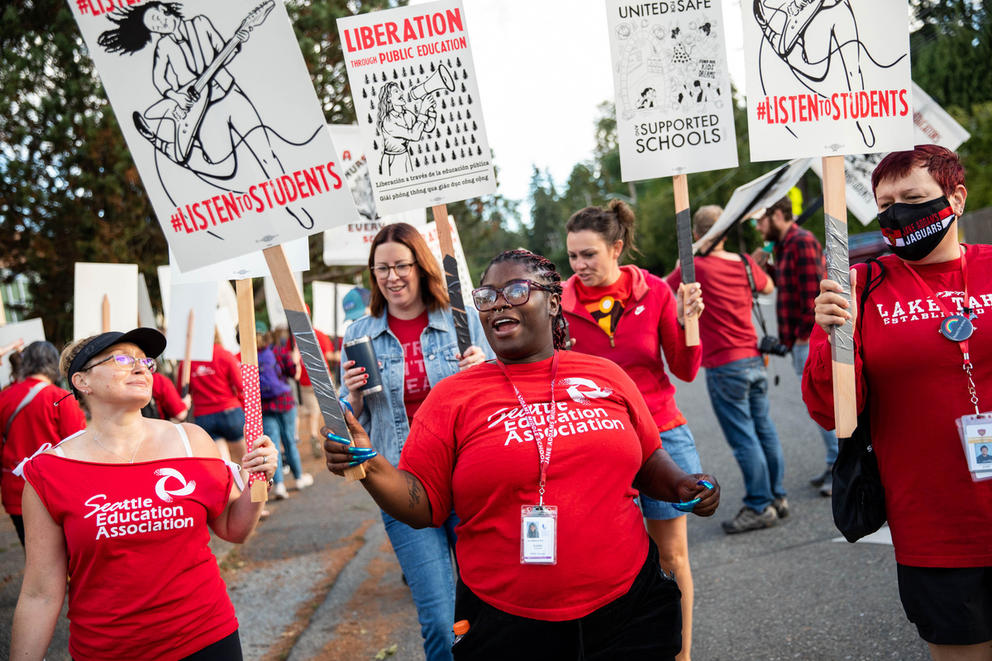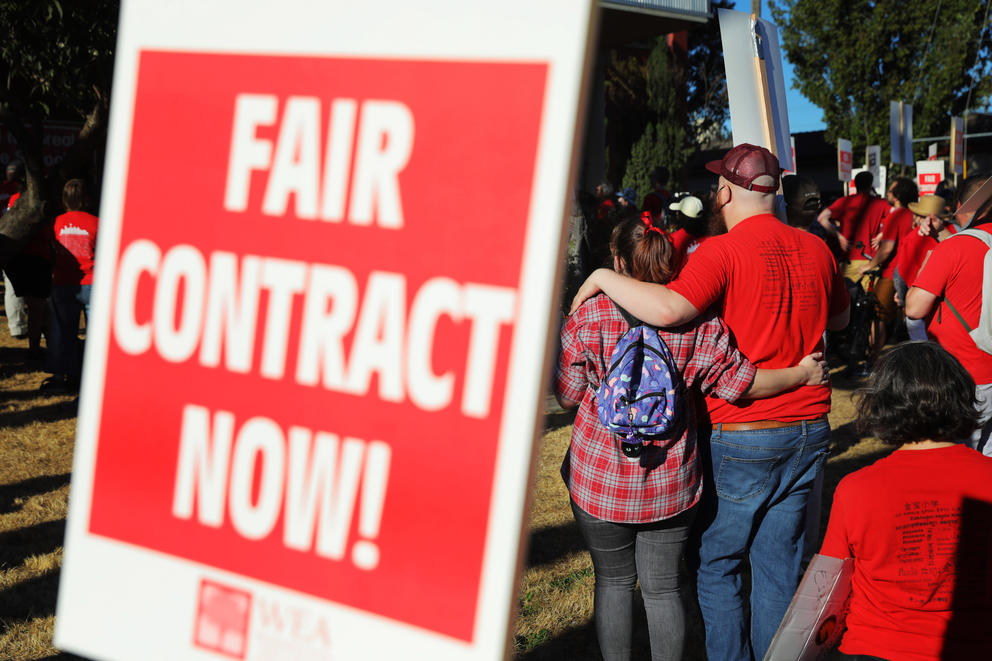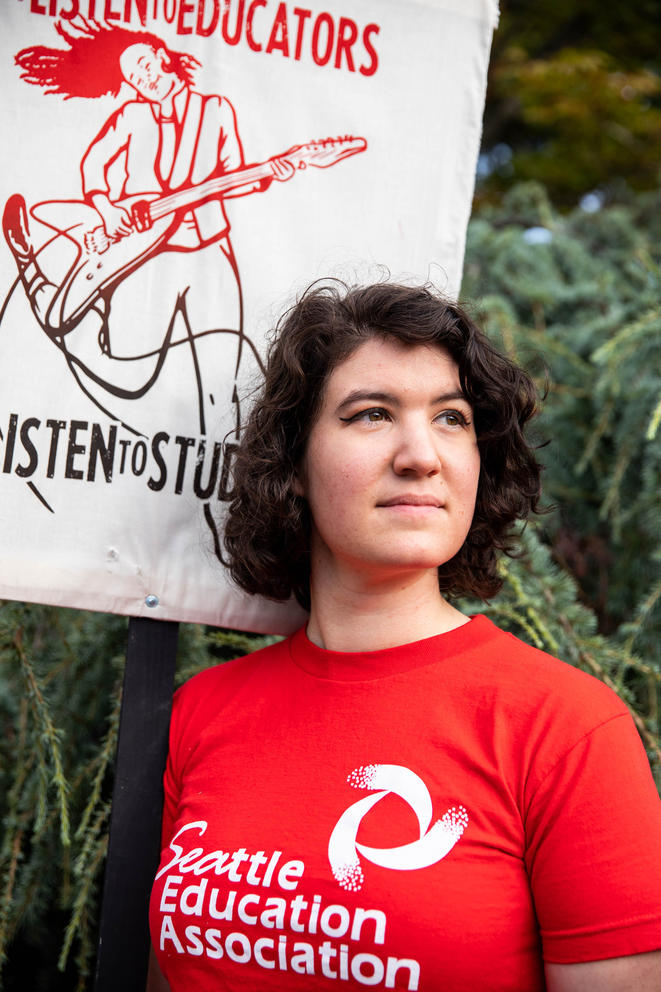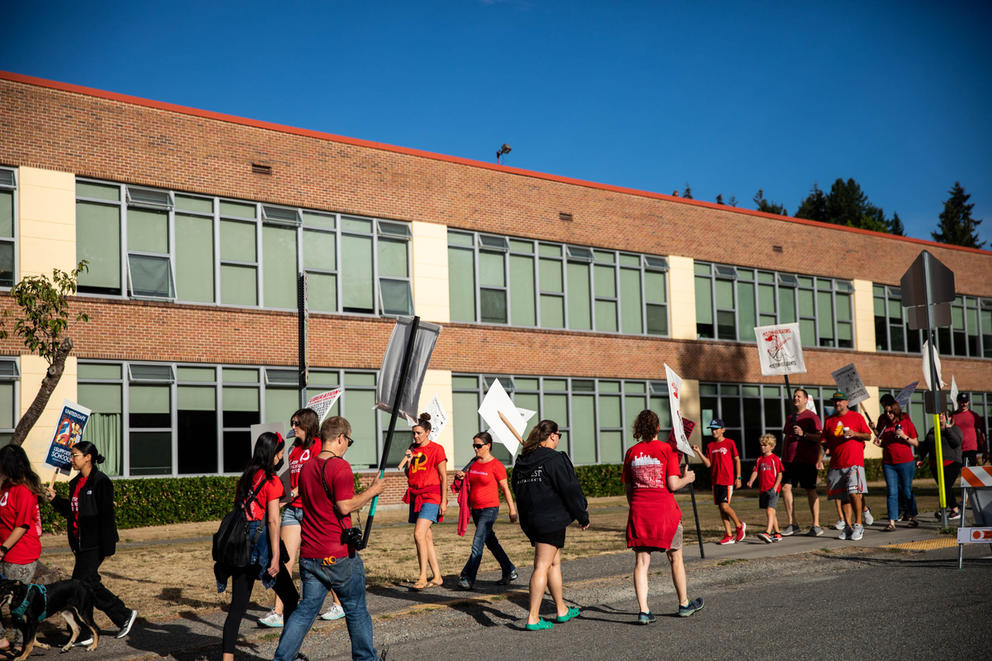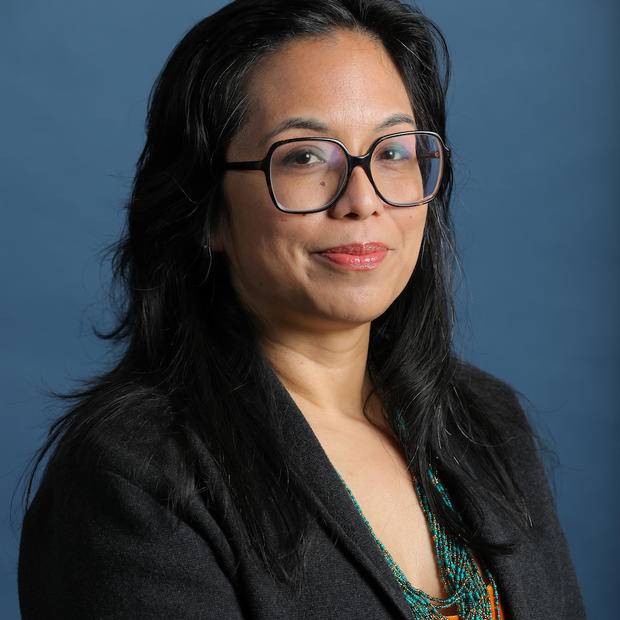Most of the money Seattle Public Schools uses to pay its teachers and other staff comes from a per-pupil allocation from state tax dollars. For this school year, the state of Washington added $236 million for a 5.5% inflation adjustment for statewide K-12 salary increases. The Seattle school district has offered to bump that up to 6.5%.
School districts can – and often do – augment teacher pay, and that money often needs to be found by cutting programs or raising the voter-approved operating levies. For example, the Olympia School District is looking to cut $17.5 million from next year’s budget, after approving an increase that adds up to 18% over three years, according to The Olympian.
Pay isn’t the only thing on negotiating tables during the first strike in seven years in Seattle.
The Seattle Education Association, the union that represents teachers and other educators, has also called for increased nurses, student mental health and social worker supports at schools, as well as for assurances of classroom staffing as the Seattle district considers a transition to placing more English Language Learners and special education students in general education classrooms.
Union president Jennifer Matter said that without a guarantee of enough instructional assistants in the classroom, teachers are concerned about how the new tasks will affect classroom workloads.
“[A]s much as we want to be able to give one-on-one support to all the students, you have… a range of 28 to 32 students in the class,” Matter said. “And no one teacher can do that all on their own. So to provide students with IEPs, that individualized attention and support, which is federally mandated, you need to have the staffing to do it.”
The Seattle Education Association represents 6,000 school employees – including instructional assistants, counselors and 3,700 teachers – in the Seattle Public Schools.
The Seattle district initially offered a 6.5% increase for teachers over the next year, and 2% and 2.1% increases over the following two years, plus retention bonuses. The Seattle Education Association is asking for greater increases, although the union did not disclose how much more than the state COLA they were seeking.
Neither the district nor the union disclosed how the differences between the proposals would impact the district’s $1.14 billion general operating budget. As of now, about 43.3% of the district general fund is budgeted for certificated salaries, which includes teachers. About 18.3% of the general fund is allocated for classified salaries, which would include all other employees, including nurses and paraeducators.
Salaries for teachers at Seattle Public Schools range from $63,180 for a first-year teacher to $123,506 at the top of the base pay scale, with the potential for further bonuses depending on other duties or having advanced degrees. According to an analysis of salaries from an OSPI school salary database, the average Seattle teacher salary was around $88,897 in 2020-21.
Seattle paraeducators, who are also members of the Seattle Education Association, get paid $19.22 an hour to start and $40.05 at the top of the scale.
Teachers said the planned change to a more inclusive classroom structure is a bigger concern than their salary increases.
Those plans were laid out in Seattle this past spring with administrators, parents and teachers. Teachers say they want to make sure that classrooms get enough support from instructional assistants, who are the ones assigned to provide additional help for students who need it.
“The district wants to essentially reorganize the entire model – and with some good reasons,” said Heather Barker, who teaches third grade at Sanislo Elementary School in the Delridge neighborhood. “They’re saying, ‘We’re redoing it, just trust us that it’s going to work.’ And we are saying, ‘Put it in writing.’”
Parent Kenton Kodner, whose son Eli Kodner is a middle-schooler, said he came to Sanislo Elementary’s picket line in West Seattle to support the teachers. “I have no problem supporting the teachers who got our children through the pandemic. I will be forever grateful for that emotional lifeline for our kids,” Kodner said.
Kodner, who said this “isn’t the first time I’ve brought my son to a strike line,” said nonetheless he wishes that the district and the teachers could have come to an agreement before the start of school. “I’m frustrated over using children as bargaining chips.”
Seattle School Board Director Vivian Song Maritz said in a statement posted to Facebook that school districts are limited in how they can spend funds – and reallocating unrestricted funds comes at the cost of other programs.
“My intention here is explain what exactly is *unyielding* – and that is how much money we get to spend. It makes the bargaining particularly challenging,” Song Maritz wrote.
In an open letter, Seattle School Board Director Lisa Rivera-Smith also said the state would have to reconsider how it funds schools.
“We can’t squeeze the water that we need to live, out of the rocks they’ve given us,” Rivera-Smith wrote.
Jane Addams Middle School eighth-grade teacher Kara Alden is on strike in solidarity with Seattle Public Schools on Wednesday, Sept. 7, 2022. Alden says she sees the impact on their special education department’s hard case load and their ability to serve students. “The changes in the contract impact special education, and they need to continue to support the students receiving special education services.” (Amanda Snyder/Crosscut)
Seattle is one of several Washington school districts to experience an educator strike this year. The Kent School District settled on a contract this week, a week after a strike delayed the scheduled start of school. The Eatonville district, east of Olympia, also has been delayed after a strike this week.
The North Thurston district, north of Olympia in Lacey, and the Port Angeles district settled contracts with their teachers before the start of school, averting strikes that would have disrupted classes.
Washington Education Association President Larry Delaney said that issues of pay, student mental health supports and workload have been common themes in these latest contract negotiations – although many of the issues have long been recognized by both teachers and administrators.
“We need to assure that educators can earn a wage that allows them to live in the communities where they work. Wages are just a piece of it. There’s also case load, class size,” Delaney said.
Still, as compensation and staffing demands rise, districts are stretching their budgets and seeking cuts – or asking communities to raise their taxes.
Delaney said teachers and school staff asking for increased compensation and support may risk layoffs and program cuts or increased operations levies – but he believes the bigger issue is how Washington residents and politicians decide to continue to pay for K-12 public schools.
“We need to have an open and honest conversation about students' needs in 2022 and beyond,” Delaney said. “Those needs have evolved and our funding for those needs have not.”

